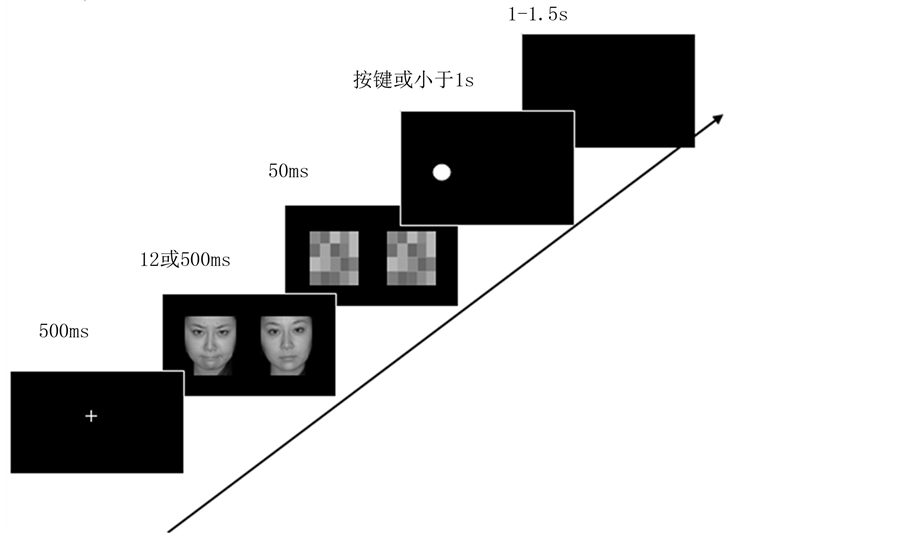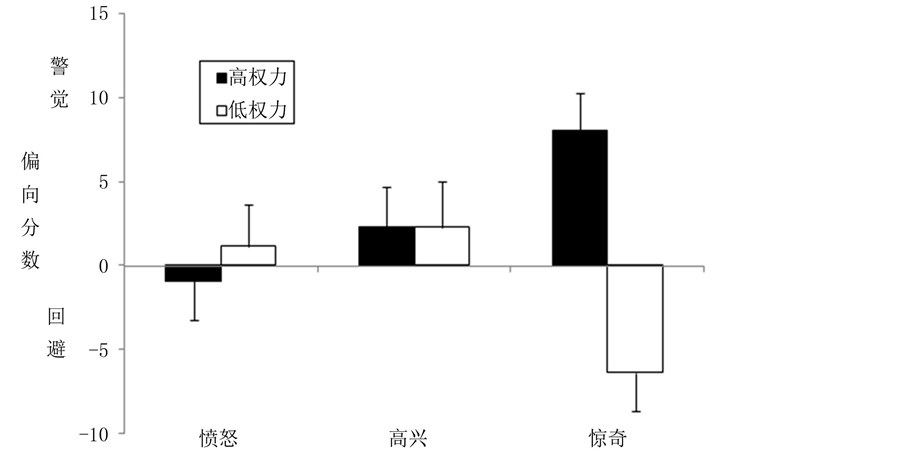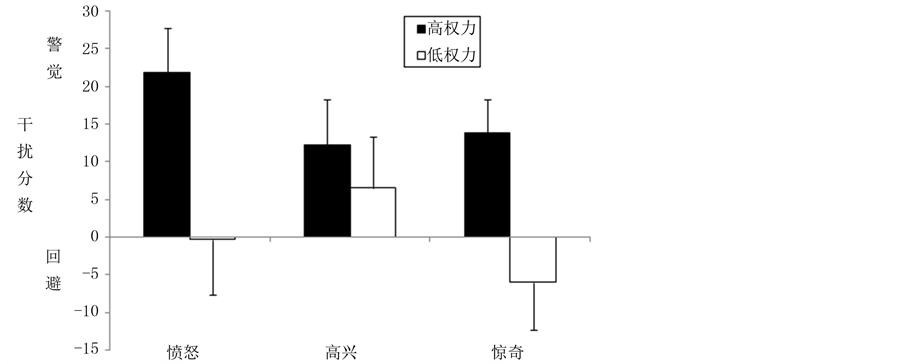1. 引言
近年来越来越多的研究者开始关注认知、情绪和人格的无意识层面。动机心理学的研究表明人类存在两种相对独立的动机系统:外显动机(explicit motives)和内隐动机(implicit motives)(McClelland, Koestner, & Weinberger, 1989)。外显动机发生于童年晚期,是人们有意识的对行为做出的归因,受社会要求和标准规范塑造和影响,它与个体能够清晰意识到的目标、价值观和期望有关。内隐动机则发生于语言尚未完全确立的认知发展早期,表现为对某种情境或线索的情感偏好,这些情境或线索在儿童早期经工具或经典条件反射与个体的愉快或痛苦体验相联结。由于发展较早,内隐动机不能被个体意识到,因此通常通过基于主题统觉测验发展而来的图片故事练习(Picture Story Exercise, PSE)来间接测量。内隐动机在许多基本认知过程中起着重要作用(Woike & Bender, 2009),尤其是在注意阶段。它指引个体选择性地注意环境中具有正向诱因(positive incentive)的线索,回避具有负向诱因(negative incentive)的线索。
作为内隐动机的一种,内隐权力动机是一种把影响和支配他人、团体或外部世界体验为奖赏而把被他人支配体验为厌恶的倾向(Winter, 1973)。高权力动机个体从影响和支配他人中体验到更多的愉悦和奖赏,而从被他人支配中体验到更多的厌恶和惩罚。由于高权力动机个体寻求支配他人并避免被他人支配,因此他们对发出支配或顺从信号的社会线索尤其敏感。最近,Schultheiss及其同事发现,支配和顺从的面部表情是内隐权力动机的一种突显的非言语诱因线索(Schultheiss & Hale, 2007; Schultheiss, Pang, Torges, Wirth, & Treynor, 2005; Schultheiss et al., 2008)。高兴和愤怒代表着表情发出者的高支配和高地位,对积极寻求支配的个体来说是厌恶的负向诱因。相反,惊奇反映了表情发出者对情境缺乏控制,代表一种低支配信号,对高权力动机个体而言是正向诱因。为支持这些预测,Schultheiss等(2005)采用内隐序列学习任务,在序列学习后呈现不同的情绪面孔。结果发现,高权力个体在低支配的惊奇面孔下表现出更好的内隐学习,而在高支配的高兴和愤怒面孔下则学习更差。进一步,他们采用点探测范式发现,相对于低权力被试,高权力被试对惊奇面孔表现出注意定向,而对高兴和愤怒面孔表现出注意回避(Schultheiss et al., 2007)。
虽然上述研究一致地发现对高权力个体而言高兴和惊奇分别代表着负向和正向诱因,但对愤怒表情的诱因价值,其他研究者却有不同的研究结果。例如,van Honk等(1999)以及Wirth等(2007)用面孔Stroop颜色命名任务发现,具有高水平睾酮(一种内隐权力动机的荷尔蒙标志)的被试对愤怒面孔的颜色命名速度比中性面孔慢,即对愤怒面孔存在选择性注意偏向。又如Hermans等(2004)采用fMRI技术发现,给健康被试服用睾酮增强了其对愤怒面孔的杏仁核激活。最近,Wang等人(2011, 2014)采用ERP表明,高权力动机个体在加工愤怒面孔时比中性面孔有更高的P3/LPP波幅,并且高权力动机个体对愤怒面孔的效价强度变化更加敏感。
从前人研究可以看出,高权力动机个体对情绪面孔刺激存在注意偏向,但是目前为止不同研究的结果还不太一致,其原因可能包括方法上的差异(不同的研究范式、不同的内隐权力动机指标、问卷测量在注意测验之前还是之后等)、不同的选择性注意指标(原始分数还是偏向分数)以及个体差异等。当前内隐动机领域内的研究大多以西方人为被试,国内关于权力动机对情绪面孔选择性注意偏向的影响的研究还很少。然而对此类问题的研究有利于我们对个体动机驱动的认知功能的进一步认识。基于此,本研究运用点探测和情绪Stroop两个实验任务,采用同一批研究被试,来逐步探讨内隐权力动机对情绪面孔的注意偏向。由于有研究表明个体在加工阈下和阈上情绪刺激时的神经通道和反应特点可能不同(Bemat, Bunce, & Shevrin, 2001),在实验一和实验二中采用了阈上和阈下两种面孔呈现时间。根据前人的研究(Schultheiss & Hale, 2007; Schultheiss et al., 2005; Wirth & Schultheiss, 2007)并经过简单的预实验,把阈下呈现时间定为12毫秒。先前研究表明当刺激呈现时间在500毫秒及其以上时,个体将采取受控的、策略性的注意加工(Adolphs, 2002),因此把阈上呈现时间定为500毫秒。
本研究预期,对不同类型的情绪面孔高权力动机个体的反应会不同,即对高兴面孔存在注意回避(表现为点探测任务中对取代中性面孔的探针比对取代高兴面孔的探针反应时更快,以及情绪Stroop任务中对高兴面孔的颜色命名速度比中性面孔更快),而对惊奇面孔存在注意偏向(表现为点探测任务中对取代惊奇面孔的探针比对取代中性面孔的探针反应时更快,以及情绪Stroop任务中对惊奇面孔的颜色命名速度比中性面孔更慢)。由于愤怒面孔的诱因价值尚不确定,先前的研究结果也有很大不同,本研究没有做明确的假设。另外,不同的面孔呈现时间下被试的反应也可能不同。
2. 实验一
2.1. 方法
2.1.1. 被试
随机选取在校本科生和研究生120人(男生53人,女生67人),根据PSE的内隐权力动机分数,得分在最高端和最低端各20%的被试分别纳入内隐权力动机高分组和低分组,最后有高分组22人(男生9人,女生13人),低分组21人(男生10人,女生11人)。所有被试裸视或矫正视力正常,实验后得到一定报酬。本研究中一半被试实验一在前实验二在后,另一半被试则相反。
2.1.2. 测量工具和实验材料
PSE要求被试根据模糊的图片刺激编写意象性故事。每张图片呈现30秒,然后给被试5分钟完成故事编写。已有研究成功地将PSE应用于中国人被试中(王其峰,许燕,2010;Hofer, Busch, Bond, Li, & Law, 2010; Wang et al., 2011, 2014)。本研究中PSE使用以下6张图片:拳击手、船长、河边夫妇、实验室女人、杂技演员和夜总会。根据Winter的动机计分系统(Winter, 1994),两名与专家编码一致性高于85%的编码者独立对故事进行编码,编码不一致处经讨论达成一致。整体样本的评分者一致性为0.78,最终样本为0.76。120名被试的故事平均长度为938字(SD = 169),平均权力动机分数为4.46(SD = 2.31)。由于权力动机分数与故事长度显著相关(r = 0.33, p < 0.001),根据公式(动机意象 ÷ 字数) × 1000,将原始分数转化为校正分数。
面孔图片来自中科院心理所制作的大学生面孔表情材料系统(王妍,罗跃嘉,2005),包括高兴–中性、愤怒–中性和惊奇–中性面孔各8对,共48张。每对由情绪面孔和对应的中性面孔组成,男女各占一半。面孔图片大小约为11厘米 × 7厘米。
2.1.3. 实验设计
本实验采用2 (权力动机水平) × 2 (呈现时间) × 3 (情绪类型) × 2 (线索类型)四因素混合设计。其中权力动机水平为组间变量,包括权力动机高分组和低分组。组内变量分别为呈现时间(12 ms, 500 ms)、情绪类型(高兴、愤怒、惊奇)和线索类型(有效线索、无效线索)。
2.1.4. 实验程序
本实验任务为点探测任务。运用E-prime程序呈现刺激,刺激呈现背景为黑色(如图1所示)。实验开始后首先在屏幕中央呈现一个注视点“+”500 ms,然后在屏幕左右侧同时呈现配对的面孔(如高兴–中性),被试眼睛与屏幕距离70 cm,面孔中心距屏幕中心约7厘米,成对的刺激图片中心间的视角约8.5˚。面孔呈现时间为12 ms或500 ms,并伴随一个50 ms的掩蔽刺激(马赛克面孔)。掩蔽刺激消失后,其中一个面孔的位置将出现一个小圆点,圆点直径5毫米,直径视角约为0.4˚。被试任务是在保证准确的前提下尽可能快地按键反应。圆点出现在左侧时按“F”键,出现在右侧时按“J”键。按键后进入下一试次,中间有时间间隔为1~1.5 s的黑屏。如果在此期间被试按键错误或超过1000 ms不做反应,实验程序将自动跳转到下一试次,该反应则记为错误反应。圆点出现在情绪图片之后为有效线索,出现在中性图片之后为无效线索。
被试首先完成16个练习试次,练习中用到的图片不包含在正式实验中。正式实验包括两个组块,分别为阈上和阈下。两个组块在被试内平衡。在每个组块中,每对情绪–中性面孔呈现4次,情绪面孔和中性面孔出现在左侧和右侧的概率均等。另外,圆点在左和在右的概率也均等。因此,每个被试需要完成192次正式实验试次,其中线索有效试次和线索无效试次各为96次。
2.2. 结果与分析
对内隐权力动机高低组进行独立样本t检验,结果表明两者之间差异极其显著,t(41) = −6.94, p < 0.001, d = 2.17。高权力组M = 7.14,SD = 1.52;低权力组M = 3.86,SD = 1.58。高低权力组之间在年龄上差异不显著,F(1, 41) = 1.26, p = 0.27;在性别比例上也没有显著差异,χ2 = 0.20, p > 0.65。删除按键错误的反应时以及小于200 ms的反应时,删除大于平均数3个标准差的反应时。有效线索和无效线索的平均反应时和标准差见表1。
对数据进行四因素重复测量方差分析表明,呈现时间主效应显著,F(1, 41) = 15.61, p < 0.001, η2 = 0.276。阈上呈现时间下被试的反应时(396.42 ms)显著长于阈下呈现时间(380.63 ms)。权力水平与线索类型交互作用显著,F(1, 41) = 5.32, p = 0.026, η2 = 0.115。更为重要的是,权力水平 × 情绪类型 × 线索类型交互效应显著,F(2, 82) = 6.22, p = 0.004, η2 = 0.132。为进一步分析三因素交互效应,计算了注意偏向分数,计算公式为无效线索平均反应时减去有效线索平均反应时。正分数表示对情绪面孔的注意偏向,负分数表示对情绪面孔的注意回避,0表示无注意偏向。此外,由于呈现时间对三因素交互效应没有调节作用,在进一步的分析中将两种呈现时间的反应时进行合并分析。
在不同情绪类型下,对高低权力组的注意偏向分数进行独立样本t检验。结果发现,在高兴和愤怒面孔条件下,高低权力组之间差异不显著,ps > 0.55。但在惊奇面孔条件下,高低权力组之间差异极其

Figure 1. Schematic illustration of the dot probe experimental procedure
图1. 点探测任务刺激流程图

Table 1. Mean reaction times and standard deviations in the dot probe task for each category and each experimental group
表1. 内隐权力动机高低组在不同呈现时间、线索和情绪类型下的反应时
显著,t(41) = −4.51, p < 0.001, d = 1.41。高权力组表现为正偏向分数(M = 8.02 ms),而低权力组表现为负偏向分数(M = −6.35 ms)。单样本t检验表明,正、负偏向分数与0之间均差异显著,t(21) = 3.91, p < 0.01;t(20) = −3.07, p < 0.01。结果见图2。

Figure 2. Indices for attentional bias in the dot probe task for each emotional face and each experimental group
图2. 内隐权力动机高低组在不同情绪类型下的偏向分数
3. 实验二
3.1. 方法
3.1.1. 被试
同实验一中的被试。
3.1.2. 实验材料
从中科院心理所制作的大学生面孔表情材料系统中选择面孔图片(王妍,罗跃嘉,2005)。高兴、愤怒、惊奇和中性面孔各10张,共40张,男女各占一半。面孔图片大小约为11厘米 × 7厘米,图片视角约为5.7˚ × 4.9˚。利用Photoshop软件将每张图片染成透明的红、绿、蓝三种颜色。
3.1.3. 实验设计
本实验采用2 (权力动机水平) × 2 (呈现时间) × 4 (情绪类型)三因素混合设计。其中权力动机水平为组间变量,包括权力动机高分组和低分组。组内变量分别为呈现时间(12 ms, 500 ms)和情绪类型(高兴、愤怒、惊奇、中性)。
3.1.4. 实验程序
本实验任务为情绪Stroop任务(如图3所示)。实验开始后首先在屏幕中央呈现一个注视点“+”500 ms,然后在屏幕中央呈现一张红色、绿色或蓝色的面孔,呈现时间为12 ms或500 ms。随后,一张掩蔽刺激(阈下条件下)被呈现。掩蔽刺激的颜色与先前呈现的面孔图片颜色一致。被试任务是判断面孔或掩蔽刺激的颜色,红色、绿色和蓝色分别对应F、J和空格键。被试按键后,面孔或掩蔽刺激消失,实验进入下一试次,中间有时间间隔为1~1.5 s的黑屏。如果在此期间被试按键错误或超过1000 ms不做反应,实验程序将自动跳转到下一试次,该反应则记为错误反应。
被试首先完成54个练习试次,练习中用到的图片不包含在正式实验中。正式实验包括两个组块,分别为阈上和阈下。两个组块在被试内平衡。在每个组块中,每张面孔呈现三次(红、绿、蓝各一次),共120次试次。因此,每个被试需要完成240次正式实验试次。
3.2. 结果与分析
数据筛选同实验一。各种条件下被试的反应时见表2。对数据进行三因素重复测量方差分析表明,呈现时间主效应显著,F(1, 41) = 16.51,p < 0.001,η2 = 0.287。阈上条件(641.66 ms)比阈下条件(604.96 ms)反应时更长。情绪类型主效应边缘显著,F(3, 123) = 2.67,p = 0.054,η2 = 0.061。对情绪类型进行多重比较发现,所有被试对愤怒面孔(628.06 ms)和惊奇面孔(626.71 ms)的反应时均显著长于中性面孔(617.29 ms),均p < 0.05。更为重要的是,权力水平与情绪类型交互效应显著,F(3, 123) = 3.10,p = 0.032,η2 = 0.070。
为进一步分析这个交互效应,计算了情绪Stroop干扰分数,即情绪面孔颜色命名平均反应时减去中性面孔颜色命名平均反应时。同样地,由于呈现时间不具调节作用,将两种呈现时间的反应时进行合并分析。在不同情绪类型下,对高低权力组的情绪Stroop干扰分数进行独立样本t检验。结果发现,在愤怒面孔条件下,高权力组(M = 21.84 ms)干扰分数显著大于低权力组(M = −0.30 ms),t(41) = −2.36,p = 0.023,d = 0.74。单样本t检验表明高权力组对愤怒面孔的干扰分数显著大于0,t(21) = 3.70,p < 0.01。在惊奇面孔条件下,高权力组(M = 13.80 ms)干扰分数显著大于低权力组(M = −5.99 ms),t(41) = −2.59,p = 0.013,d = 0.81。单样本t检验表明高权力组对惊奇面孔的干扰分数显著大于0,t(21) = 3.10,p < 0.01,而低权力组的干扰分数与0没有显著差异,t(20) = −0.96,p = 0.35。对于高兴面孔条件下的Stroop干扰分数,高低权力组之间没有显著差异,p > 0.53。结果见图4。

Figure 3. Schematic illustration of the emotional Stroop experimental procedure
图3. 情绪Stroop任务刺激流程图

Table 2. Mean reaction times and standard deviations in the Stroop task for each category and each experimental group
表2. 内隐权力动机高低组在不同呈现时间和情绪类型下的颜色命名反应时

Figure 4. Indices for attentional bias in the emotional Stroop task for each emotional face and each experimental group
图4. 内隐权力动机高低组在不同情绪类型下的干扰分数
对注意偏向分数和情绪Stroop干扰分数在各情绪类型下进行相关分析。结果表明,在愤怒面孔条件下,两者之间有显著负相关,r = −0.31,p < 0.05。在高兴和惊奇面孔条件下,两者之间相关不显著,r分别为0.17和0.11,ps > 0.27。
4. 讨论
本研究的主要目的是考察内隐权力动机对不同类型情绪面孔注意偏向的影响。鉴于先前点探测和情绪Stroop任务间结果的不一致,本研究同时采用了这两种认知任务来进一步考察这一现象。点探测和情绪Stroop任务一致发现,相对于低权力动机个体而言,高权力动机个体对惊奇面孔存在注意偏向,而对高兴面孔不存在注意偏向。对于愤怒面孔,仅在情绪Stroop任务中发现了注意偏向的存在。相关分析表明,两种任务在高兴和惊奇面孔条件下没有显著相关,而在愤怒面孔条件下有显著负相关。
在点探测任务中,高权力动机被试对出现在惊奇面孔位置的探针有更快的反应时,即表现出对惊奇面孔的注意偏向,这与Schultheiss等(2007)的研究结果相一致。这一发现在本研究中进一步得到了情绪Stroop任务的证实:高权力动机个体对惊奇面孔的颜色命名时间比中性面孔更长。当一个人的预期被违背时,惊奇的表情会经常出现。在社会互动情境中,这样的预期违背通常是由于另一方的言语或非言语行为造成的。因此,惊奇表情反映了表情发出者与知觉者的权力分化:表情知觉者对情境比表情发出者有更高的控制和支配性(Stanton, Hall, & Schultheiss, 2010)。这样,对高权力动机个体来说,惊奇表情成为了具有正向诱因价值的低支配信号并因此吸引了其注意。
相对于低支配的惊奇表情,高兴表情通常被评定为高支配信号(Knutson, 1996)。因此对高权力动机个体来说是一种负向诱因。然而,在本研究中两种任务都没有发现高权力动机被试对高兴面孔的注意回避。这与先前的研究结果相一致,即服用睾酮后被试对高兴面孔反应时心率并没有明显加快(van Hock et al., 2001)。值得指出的是,在Schultheiss等(2007)的研究中,他们也并没有发现高权力动机个体对高兴面孔的注意回避,只是在将高兴和愤怒两种高支配表情合并分析的情况下,才发现了注意回避的存在。因此,高兴表情的诱因价值可能是相对模糊的,并依赖于很多情境因素。例如,相对于同性个体的微笑,一个来自异性个体的微笑可能具有更小的支配性(Stanton et al., 2010)。此外,注视方向可能也会改变高兴表情的意义。一个抬起下巴的微笑会被看成是一种炫耀而代表高支配信号;而低头害羞的微笑则代表了一种低支配信号。总之,高兴表情对高权力动机个体的诱因价值尚不确定,将来的研究应该进一步考察各种情境因素对其诱因价值的影响。
对于愤怒表情,本研究中两种认知任务表现出不一致的结果。在情绪Stroop任务中高权力动机被试对愤怒面孔存在注意偏向,但在点探测任务中高低权力动机组之间没有显著差异。虽然Schultheiss等人认为愤怒表情是一种高支配信号,高权力动机个体会将其体验为厌恶刺激并极力回避,但其他研究者却发现高权力动机个体对愤怒表情表现出注意朝向。有研究表明睾酮水平高的个体倾向于参与支配性挑战,他们似乎趋向发出这种挑战的信号(Josephs, Sellers, Newman, & Mehta, 2006)。因此,愤怒表情对高权力动机个体而言可能是有奖赏价值的,因为它们意味着表情发出者的沮丧和挫折,而这对于寻求支配他人的个体来说是一种积极结果。这种观点也与先前的研究发现相一致,即引发他人低水平的愤怒(如戏弄他人)对知觉者实际上有正向诱因价值(Keltner, Young, Heerey, Oemig, & Monarch, 1998),尤其当知觉者有很高的权力或支配需要时。
造成点探测和情绪Stroop任务不同结果的另一个原因可能是两种任务反映了不同的注意机制(Mogg, Bradley, Dixon, Fisher, Twelftree, & McWilliams, 2000; Wirth & Schultheiss, 2007)。相关分析表明,点探测和情绪Stroop任务在注意偏向分数上有很小的相关,在愤怒面孔条件下甚至有显著的负相关。首先,两种任务对被试的要求不同。在点探测任务中,被试可以在两种刺激间进行选择,这样测得的注意偏向包含了注意转移、保持和解除等多种成分,然而情绪Stroop任务要求被试注意面孔的颜色而忽略其表情,这涉及了单一刺激不同属性(颜色和表情)间的加工竞争(Mogg et al., 2000)。其次,两种任务可能与不同的行为调节系统相联系(Wirth & Schultheiss, 2007)。例如,Putman等(2004)发现在Stroop任务中,行为激活系统与对愤怒面孔的Stroop干扰相关;然而Mogg,Bradley和Hallowell(1994)在点探测任务中发现,与焦虑相关的行为抑制系统促进了对愤怒面孔的警觉反应。正如前面指出的,愤怒表情对高权力动机个体来说可能是具有奖赏性质的正向诱因,因此激活了行为激活系统,并导致了Stroop任务中对愤怒面孔的注意偏向。同时,愤怒表情的奖赏性降低了高权力动机个体的焦虑(激活了行为抑制系统),因此减少了点探测任务中对愤怒面孔的注意偏向。
值得注意的是,本研究没有发现不同的面孔呈现时间对被试反应有不同的影响。这与先前的研究发现相一致,即在动机驱动的认知过程中缺乏阈下/阈上效应的存在(Schultheiss & Hale, 2007; Schultheiss et al., 2005),其原因可能与内隐动机的脑机制有关。LeDoux(2002)认为内隐动机受由杏仁核、纹状体和眶额皮质组成的动机回路调节,这一回路驱动了个体对正向或负向诱因的自动化反应。因此当出现突显的诱因线索(如情绪面孔)时,无论个体能否清晰知觉到刺激,都能迅速唤起个体的内隐动机,并指引个体的选择性注意。
本研究首次同时采用点探测和情绪Stroop任务来考察内隐权力动机对情绪面孔注意偏向的影响,结果证明了支配和顺从的面部表情是内隐权力动机的一种突显的诱因线索,它们与内隐权力动机相互作用塑造了个体的注意定向。虽然发现了以上一些很有意义的结果,但本研究尚存一定的局限性。首先,本研究只包含了三种情绪面孔,将来的研究应该进一步扩展到其他表情(如厌恶、恐惧等)。其次,本研究没有测量被试的焦虑水平并在分析中控制该变量。大量证据表明高焦虑被试存在对威胁性信息的注意偏向(Williams, Watts, MacLeod, & Mathews, 1997)。最后,在本研究中情绪效价强度是不变的。情绪效价强度对注意偏向的影响已经在其他许多动机性结构中得到证实(Yuan, He, Lei, Yang, & Li, 2009; Wang et al., 2014)。因此将来的研究应该探讨效价强度是否影响了高权力动机个体对情绪面孔的加工。
5. 结论
1) 在点探测任务中,高权力动机个体对惊奇面孔存在注意偏向,但在高兴和愤怒面孔条件下,高低权力动机者之间没有显著差异。
2) 在情绪Stroop任务中,高权力动机个体对惊奇和愤怒面孔表现出注意偏向,但对高兴面孔高低权力动机者之间没有显著差异。
基金项目
四川省软科学研究计划项目(2012ER0048);四川应用心理学研究中心资助项目(CSXL-143002);成都医学院校自然科学基金(CYZ13-013)。

NOTES
*通讯作者。